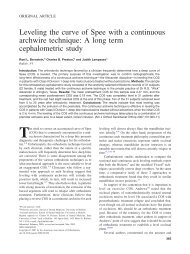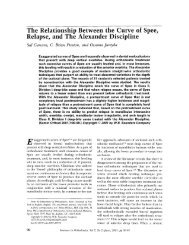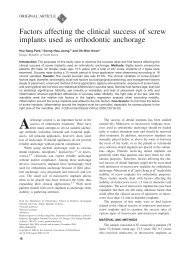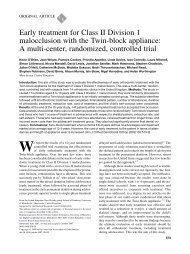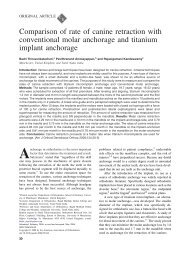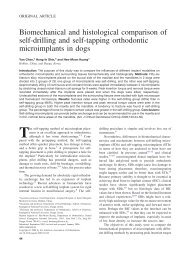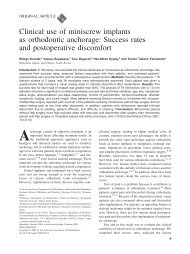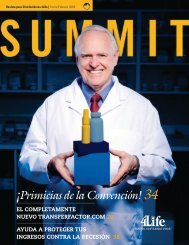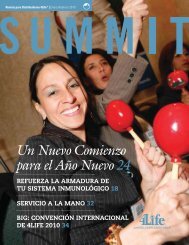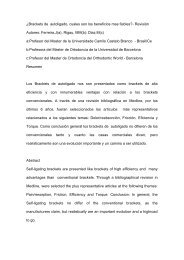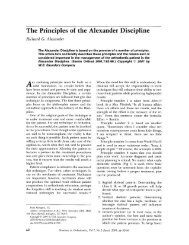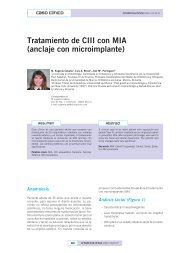A Follow-up Study of Early Treatment of Pseudo Class III Malocclusion
A Follow-up Study of Early Treatment of Pseudo Class III Malocclusion
A Follow-up Study of Early Treatment of Pseudo Class III Malocclusion
Create successful ePaper yourself
Turn your PDF publications into a flip-book with our unique Google optimized e-Paper software.
Original Article<br />
A <strong>Follow</strong>-<strong>up</strong> <strong>Study</strong> <strong>of</strong> <strong>Early</strong> <strong>Treatment</strong> <strong>of</strong> <strong>Pseudo</strong><br />
<strong>Class</strong> <strong>III</strong> <strong>Malocclusion</strong><br />
Urban Hägg, DDS, Odont Dr, FHKAM, FCDSHK(Ortho), FDRSRCS(Edin), PhD; a<br />
Agnes Tse, BDS, MOrth; b Margareta Bendeus, DDS, FHKAM(Dental Surgery), FCDSHK(Ortho); c<br />
A. Bakr M. Rabie, BDS Cairo, MS, PhD, Cert Orth Northwestern, FHKAM(Dental Surgery),<br />
FCDSHK(Ortho) d<br />
Abstract: This study investigated the long-term outcome <strong>of</strong> 27 consecutive young patients diagnosed<br />
with pseudo <strong>Class</strong> <strong>III</strong> malocclusion treated with simple fixed appliance (2 4 appliance), which resulted<br />
in a positive overjet in all cases. Of the original sample <strong>of</strong> 27 patients, 25 patients (93%) were examined<br />
at the five-year follow-<strong>up</strong>. Two patients dropped out soon after the active treatment was completed. Of<br />
the remaining 25 patients, 20 patients had had no other treatment other than treatment with 2 4 appliance,<br />
and the other five patients had undergone additional comprehensive fixed appliance therapy because <strong>of</strong><br />
crowding. Lateral cephalograms were obtained before and after active treatment with the 2 4 appliance<br />
and at five-year follow-<strong>up</strong>. The long-term results showed that at the five-year follow-<strong>up</strong> all 25 patients<br />
still maintained a positive overjet. The immediate treatment outcome in the sagittal plane was the same<br />
for those who had had 2 4 appliance treatment only and those who had had additional treatment with<br />
comprehensive fixed appliance treatment, but lower face height increased (P .01) and the mandibular<br />
plane angle opened (P .05) more in those who had had additional treatment, comprehensive fixed<br />
appliance treatment. During the five-year follow-<strong>up</strong> period, the dental compensation and the growth <strong>of</strong> the<br />
jaw were similar in both gro<strong>up</strong>s. In conclusion, in young patients diagnosed with pseudo <strong>Class</strong> <strong>III</strong> malocclusion<br />
and treated early with a 2 4 appliance, the overjet was corrected, and the treatment result was<br />
maintained in the long term. (Angle Orthod 2004;74:465–472.)<br />
Key Words: <strong>Class</strong> <strong>III</strong> malocclusion; Orthodontics; Interceptive<br />
INTRODUCTION<br />
In the Chinese population, the prevalence <strong>of</strong> <strong>Class</strong> <strong>III</strong> malocclusion<br />
is comparatively high, involving one <strong>of</strong> 20 individuals.<br />
Of these, more than half have pseudo <strong>Class</strong> <strong>III</strong> malocclusion.<br />
1 The diagnosis <strong>of</strong> pseudo <strong>Class</strong> <strong>III</strong> malocclusion<br />
differs from that <strong>of</strong> skeletal <strong>Class</strong> <strong>III</strong> malocclusion because<br />
it is defined as functional forward displacement <strong>of</strong> the mandible<br />
as a result <strong>of</strong> retroclined maxillary incisors. 2–6 Because<br />
the major underlying cause <strong>of</strong> pseudo <strong>Class</strong> <strong>III</strong> malocclusion<br />
a Chair, Pr<strong>of</strong>essor in Orthodontics, Faculty <strong>of</strong> Dentistry, The University<br />
<strong>of</strong> Hong Kong, Hong Kong SAR, China.<br />
b Postgraduate Student, Orthodontics, Faculty <strong>of</strong> Dentistry, The<br />
University <strong>of</strong> Hong Kong, Hong Kong SAR, China.<br />
c Assistant Pr<strong>of</strong>essor, Faculty <strong>of</strong> Dentistry, The University <strong>of</strong> Hong<br />
Kong, Hong Kong SAR, China.<br />
d Pr<strong>of</strong>essor in Orthodontics, Director, Hard Tissue Research, Faculty<br />
<strong>of</strong> Dentistry, The University <strong>of</strong> Hong Kong, Hong Kong SAR, China.<br />
Corresponding author: Urban Hägg, DDS, Odont Dr, FHKAM,<br />
FCDSHK(Ortho), FDRSRCS(Edin), PhD, Faculty <strong>of</strong> Dentistry, The<br />
University <strong>of</strong> Hong Kong, Hong Kong SAR, China<br />
Accepted: August 2003. Submitted: June 2003.<br />
2004 by The EH Angle Education and Research Foundation, Inc.<br />
465<br />
is the inclination <strong>of</strong> the maxillary incisors, the treatment objectives<br />
aim to change the inclination <strong>of</strong> those incisors.<br />
In general terms, the goal <strong>of</strong> interceptive orthodontics is<br />
to prevent an existing problem from getting worse. Specifically<br />
for pseudo <strong>Class</strong> <strong>III</strong>, the goals <strong>of</strong> early treatment are<br />
to correct the anterior displacement <strong>of</strong> the mandible before<br />
the er<strong>up</strong>tion <strong>of</strong> the canines and premolars so that they can<br />
be guided into <strong>Class</strong> I in the proper mandibular position,<br />
to provide space for the er<strong>up</strong>tion <strong>of</strong> the buccal segments as<br />
a result <strong>of</strong> proclination <strong>of</strong> the <strong>up</strong>per incisor, and to provide<br />
a normal environment for the growth <strong>of</strong> the maxilla, eliminating<br />
the anterior crossbite. 1,4,7<br />
Various appliances have been devised for early treatment<br />
<strong>of</strong> a pseudo <strong>Class</strong> <strong>III</strong>, such as removable plates with<br />
springs, fixed or removable inclined planes, functional appliances,<br />
chin-c<strong>up</strong>s, and simple fixed appliances. 5,8,9 One<br />
popular type <strong>of</strong> simple fixed appliance is the 2 4 appliance,<br />
which is composed <strong>of</strong> bands on the first permanent<br />
maxillary molars, brackets on the maxillary incisors, and a<br />
wire with advancing loops. 9<br />
Most clinical studies seemingly are based on retrospectively<br />
selected samples with favorable results, and this is<br />
Angle Orthodontist, Vol 74, No 4, 2004
466 HÄGG, TSE, BENDEUS, RABIE<br />
TABLE 1. Age (y) at Start <strong>of</strong> <strong>Treatment</strong> (T0), End <strong>of</strong> <strong>Treatment</strong> (T1), and Five-y <strong>Follow</strong>-<strong>up</strong> (T2); and Duration <strong>of</strong> the <strong>Treatment</strong>/Observation<br />
Period (y) <strong>of</strong> 27 Patients Treated by Simple 2 4 Fixed Appliance<br />
Gro<strong>up</strong> n Age at T0 SD Age at T1 SD<br />
Initial sample<br />
Present gro<strong>up</strong><br />
Gro<strong>up</strong> with 2 4 treatment only<br />
Gro<strong>up</strong> with extended treatment<br />
Dropout<br />
Angle Orthodontist, Vol 74, No 4, 2004<br />
27<br />
25<br />
20<br />
5<br />
2<br />
10.1<br />
10.2<br />
10.2<br />
10.3<br />
8.7<br />
1.54<br />
1.53<br />
1.31<br />
2.41<br />
1.14<br />
10.7<br />
11.0<br />
10.8<br />
10.9<br />
9.2<br />
1.50<br />
1.50<br />
1.30<br />
2.33<br />
0.42<br />
Duration <strong>of</strong><br />
<strong>Treatment</strong><br />
(T0-T1) Age at T2 SD<br />
0.63<br />
0.64<br />
0.63<br />
0.65<br />
0.55<br />
—<br />
16.5<br />
16.1<br />
18.0<br />
—<br />
2.25<br />
1.91<br />
3.10<br />
Duration <strong>of</strong><br />
<strong>Follow</strong>-<strong>up</strong><br />
(T1-T2)<br />
P value .423 a .344 a .950 a .097 b .006 b<br />
a ANOVA.<br />
b t-test.<br />
** P .01.<br />
TABLE 2. Description <strong>of</strong> Five Patients who had 2 4 Appliance <strong>Treatment</strong> <strong>Follow</strong>ed by Comprehensive Fixed Appliance (FA) <strong>Treatment</strong><br />
(Extended <strong>Treatment</strong> Gro<strong>up</strong>) During the Five-y <strong>Follow</strong>-<strong>up</strong>. Age (y) at Start <strong>of</strong> <strong>Treatment</strong> (T0), End <strong>of</strong> 2 4 Appliance <strong>Treatment</strong> (T1), and at<br />
<strong>Follow</strong>-<strong>up</strong> (T2)<br />
Extended treatment gro<strong>up</strong><br />
1LSC<br />
2LWC<br />
3TPM<br />
4YHY<br />
5YYH<br />
Age at T0 Age at T1 Age at T2<br />
9.5<br />
7.7<br />
8.8<br />
13.7<br />
11.6<br />
10.1<br />
8.3<br />
9.6<br />
14.2<br />
12.4<br />
16.1<br />
15.6<br />
15.7<br />
22.4<br />
20.1<br />
FIGURE 1. Cephalometric analysis in the sagittal dimension: overjet<br />
(is-ii), maxillary base (OLp-ss), mandibular base (OLp-Pg), base<br />
relationship (ss-Pg), maxillary incisor (ss-is), mandibular incisor (ii-<br />
Pg), maxillary molar (ms-ss), and mandibular molar (mi-Pg) (Pancherz<br />
14 and Hägg et al 17 ).<br />
Age at Start<br />
<strong>of</strong> FA <strong>Malocclusion</strong> <strong>Treatment</strong><br />
After T1<br />
After T1<br />
Two y after T1<br />
After T1<br />
One y after T1<br />
Crowding<br />
Malalignment<br />
Malalignment<br />
Impacted 13<br />
Malalignment<br />
5.6<br />
5.3<br />
7.1<br />
—<br />
Extraction 14, 24, 34, 44<br />
Nonextraction<br />
Nonextraction<br />
Nonextraction<br />
Nonextraction<br />
FIGURE 2. Cephalometric analysis in the vertical dimension: overbite<br />
(is-ii), lower facial height (sp-gn), maxillary central incisor (is-<br />
NL), mandibular central incisor (ii-ML), mandibular plane angle (ML/<br />
NSL), maxillary plane angle (NL/NSL), maxillary occlusal plane angle<br />
(Ols/NSL), and mandibular occlusal plane angle (Oli/NSL)<br />
(Pancherz 15 and Hägg et al 17 ).
EARLY TREATMENT OF PSEUDO CLASS <strong>III</strong> MALOCCLUSION<br />
FIGURE 3. Overjet: treatment changes (T0-T1) in the 2 4 appliance only gro<strong>up</strong> (a) and the extended treatment gro<strong>up</strong> (b); posttreatment<br />
changes (T1-T2) in the 2 4 appliance only gro<strong>up</strong> (c) and the extended treatment gro<strong>up</strong> (d); total changes (T0-T2) in the 2 4 appliance<br />
only gro<strong>up</strong> (e) and the extended treatment gro<strong>up</strong> (f).<br />
likely to result in biased results. 10–12 To better evaluate a<br />
success rate, it is necessary to follow consecutively treated<br />
cases for a reasonable time and also to describe the inevitable<br />
dropout. Ideally, one would like to follow patients<br />
treated at a young age until growth ceases. However, be-<br />
467<br />
cause pseudo <strong>Class</strong> <strong>III</strong> is characterized by dental problems<br />
and the early treatment is aimed at correcting the angulation<br />
<strong>of</strong> the <strong>up</strong>per incisors, the follow-<strong>up</strong> period should be extended<br />
until the er<strong>up</strong>tion <strong>of</strong> all the permanent dentition except<br />
the third molars. Accordingly, we decided to follow-<br />
Angle Orthodontist, Vol 74, No 4, 2004
468 HÄGG, TSE, BENDEUS, RABIE<br />
TABLE 3. Dent<strong>of</strong>acial Morphology <strong>of</strong> the <strong>Pseudo</strong> <strong>Class</strong> <strong>III</strong> Subjects at the Start <strong>of</strong> <strong>Treatment</strong> (T0), End <strong>of</strong> <strong>Treatment</strong> (T1), and Five-y <strong>Follow</strong><strong>up</strong><br />
(T2)<br />
Variable<br />
Pancherz’s analysis<br />
Sagittal plane<br />
Overjet<br />
Maxillary base<br />
Mandibular base<br />
Base relationship<br />
Maxillary incisor<br />
Mandibular incisor<br />
Maxillary molar<br />
Mandibular molar<br />
Molar relationship<br />
Vertical plane<br />
Overbite<br />
Lower facial height<br />
Maxillary incisor<br />
Mandibular incisor<br />
Maxillary molar<br />
Mandibular molar<br />
Mandibular plane angle<br />
Maxillary plane angle<br />
Maxillary occlusal plane angle<br />
Mandibular occlusal plane angle<br />
Angle Orthodontist, Vol 74, No 4, 2004<br />
Original<br />
(n 27)<br />
Mean SD<br />
1.7<br />
72.1<br />
80.5<br />
8.4<br />
7.3<br />
0.6<br />
21.6<br />
27.9<br />
2.1<br />
1.1<br />
61.6<br />
27.3<br />
40.9<br />
21.3<br />
31.3<br />
35.6<br />
8.7<br />
20.5<br />
17.0<br />
1.07<br />
3.60<br />
3.47<br />
2.87<br />
1.61<br />
2.68<br />
2.08<br />
2.74<br />
1.95<br />
1.75<br />
3.55<br />
2.03<br />
1.94<br />
2.55<br />
3.04<br />
5.75<br />
3.23<br />
5.19<br />
5.50<br />
Dropout<br />
(D)<br />
(n 2)<br />
Mean<br />
3.5<br />
71.0<br />
81.3<br />
10.3<br />
7.0<br />
0.3<br />
21.0<br />
25.0<br />
6.3<br />
3.0<br />
59.5<br />
26.0<br />
40.3<br />
21.3<br />
27.5<br />
37.5<br />
11.0<br />
20.5<br />
11.0<br />
Present (P)<br />
(n 25)<br />
Mean SD<br />
1.6<br />
72.2<br />
80.4<br />
8.2<br />
7.3<br />
0.6<br />
21.7<br />
28.1<br />
1.8<br />
1.0<br />
61.8<br />
27.4<br />
41.0<br />
21.3<br />
31.6<br />
35.4<br />
8.5<br />
20.5<br />
17.5<br />
0.96<br />
3.74<br />
3.61<br />
2.93<br />
1.67<br />
2.78<br />
2.16<br />
2.70<br />
1.57<br />
1.73<br />
3.61<br />
2.00<br />
1.98<br />
2.65<br />
2.94<br />
5.87<br />
3.27<br />
5.35<br />
5.40<br />
P-D a<br />
d<br />
1.9*<br />
1.2<br />
0.8<br />
2.0<br />
0.3<br />
0.4<br />
0.7<br />
3.1<br />
4.5***<br />
2.0<br />
2.3<br />
1.4<br />
0.7<br />
0.1<br />
4.1<br />
2.1<br />
2.5<br />
0.0<br />
6.5<br />
a P D difference between the present subjects (n 25) and dropout gro<strong>up</strong> (n 2).<br />
b Diff, difference between 2 4 appliance treatment only gro<strong>up</strong> and extended treatment gro<strong>up</strong>.<br />
* P .05; ** P .01.<br />
<strong>up</strong> all consecutively treated patients for a period <strong>of</strong> five<br />
years.<br />
Previously, we reported a series <strong>of</strong> consecutive young<br />
patients with pseudo <strong>Class</strong> <strong>III</strong> malocclusion, in whom the<br />
simple 2 4 appliance efficiently corrected the malocclusion.<br />
In that sample, the selection criteria were a <strong>Class</strong> <strong>III</strong><br />
2 4 Only<br />
(n 20)<br />
Mean SD<br />
1.4<br />
72.4<br />
80.2<br />
7.9<br />
7.3<br />
0.8<br />
21.8<br />
28.1<br />
1.6<br />
0.7<br />
62.1<br />
27.4<br />
40.7<br />
20.8<br />
31.7<br />
35.3<br />
8.3<br />
20.8<br />
18.3<br />
0.76<br />
3.92<br />
3.64<br />
3.08<br />
1.77<br />
3.04<br />
2.20<br />
3.06<br />
1.62<br />
1.76<br />
3.58<br />
2.03<br />
1.87<br />
2.46<br />
3.21<br />
6.22<br />
3.46<br />
5.87<br />
5.38<br />
T0<br />
Extended<br />
<strong>Treatment</strong><br />
(n 5)<br />
Mean SD<br />
2.5<br />
71.4<br />
81.2<br />
9.8<br />
7.5<br />
0.2<br />
21.2<br />
28.4<br />
2.6<br />
2.0<br />
60.6<br />
27.4<br />
42.2<br />
23.2<br />
31.1<br />
36.0<br />
9.2<br />
19.2<br />
14.6<br />
1.22<br />
3.11<br />
3.77<br />
1.60<br />
1.37<br />
1.48<br />
2.14<br />
1.95<br />
1.14<br />
1.22<br />
3.91<br />
2.07<br />
2.17<br />
2.77<br />
1.60<br />
4.74<br />
2.59<br />
2.28<br />
4.93<br />
Diff b<br />
d<br />
1.15*<br />
0.95<br />
1.00<br />
1.95<br />
0.25<br />
0.55<br />
0.63<br />
0.32<br />
1.00<br />
1.3<br />
1.5<br />
0.05<br />
1.53<br />
2.38<br />
0.63<br />
0.75<br />
0.88<br />
1.63<br />
3.65<br />
TABLE 4. Sagittal <strong>Treatment</strong> Changes (T0-T1), Posttreatment Changes (T1-T2), and Total Changes (T0-T2) in 2 4 Appliance Only Gro<strong>up</strong><br />
(n 20) and Extended <strong>Treatment</strong> Gro<strong>up</strong> (n 5)<br />
Variable<br />
Pancherz’s analysis (sagittal plane)<br />
Overjet<br />
Maxillary base<br />
Mandibular base<br />
Base relationship<br />
Maxillary incisor<br />
Mandibular incisor<br />
Maxillary molar<br />
Mandibular molar<br />
Molar relationship<br />
2 4 Only<br />
Mean SD<br />
4.7***<br />
0.9***<br />
1.6**<br />
0.7<br />
4.1***<br />
1.3***<br />
1.6***<br />
0.2<br />
2.1**<br />
0.97<br />
0.45<br />
1.83<br />
1.84<br />
1.65<br />
1.35<br />
1.45<br />
1.36<br />
2.70<br />
T0-T1<br />
Extended <strong>Treatment</strong><br />
Mean SD Diff a<br />
4.8**<br />
0.9*<br />
1.1<br />
0.2<br />
3.5**<br />
1.5*<br />
0.3<br />
0.7<br />
0.2<br />
1.10<br />
0.55<br />
0.89<br />
0.57<br />
1.22<br />
1.00<br />
0.91<br />
1.30<br />
1.15<br />
0.1<br />
0.0<br />
0.5<br />
0.5<br />
0.6<br />
0.2<br />
1.3<br />
0.5<br />
2.3<br />
2 4 Only<br />
Mean SD<br />
0.0<br />
3.2***<br />
4.8***<br />
1.7**<br />
1.5**<br />
0.1<br />
1.5**<br />
0.5<br />
0.7<br />
a Diff, difference between 2 4 appliance treatment only gro<strong>up</strong> and extended treatment gro<strong>up</strong>.<br />
* P .05; ** P .01; *** P .001.<br />
incisor relationship (at least two incisors in crossbite) in<br />
centric occlusion, in the early mixed dentition, without exfoliation<br />
<strong>of</strong> the second primary molars, exhibiting mandibular<br />
displacement and the patients did not have orthodontic<br />
therapy before the treatment related to the study. 7 These<br />
patients were successfully treated with the simple 2 4<br />
1.19<br />
1.87<br />
1.44<br />
1.96<br />
2.19<br />
1.78<br />
1.81<br />
1.56<br />
1.55<br />
T1-T2<br />
Extended <strong>Treatment</strong><br />
Mean SD Diff<br />
0.1<br />
4.1*<br />
5.7**<br />
1.6<br />
2.4<br />
0.7<br />
1.9<br />
2.2<br />
1.9<br />
1.08<br />
2.19<br />
2.68<br />
1.52<br />
3.61<br />
2.77<br />
1.56<br />
2.14<br />
1.92<br />
0.1<br />
1.0<br />
0.9<br />
0.0<br />
0.9<br />
0.8<br />
0.4<br />
1.7<br />
1.3
EARLY TREATMENT OF PSEUDO CLASS <strong>III</strong> MALOCCLUSION<br />
2 4 Only<br />
(n 20)<br />
Mean SD<br />
3.3<br />
73.3<br />
81.8<br />
8.6<br />
11.3<br />
0.5<br />
23.4<br />
28.3<br />
3.7<br />
1.7<br />
63.9<br />
28.0<br />
42.3<br />
21.4<br />
32.8<br />
36.9<br />
8.4<br />
20.1<br />
16.9<br />
0.78<br />
3.92<br />
4.12<br />
4.14<br />
2.42<br />
3.50<br />
3.00<br />
3.06<br />
2.47<br />
0.80<br />
3.49<br />
1.96<br />
1.66<br />
1.88<br />
3.10<br />
5.51<br />
3.54<br />
5.44<br />
4.63<br />
T1<br />
Extended<br />
<strong>Treatment</strong><br />
(n 5)<br />
Mean SD<br />
2.3<br />
72.3<br />
82.3<br />
10.0<br />
11.0<br />
1.3<br />
21.5<br />
29.1<br />
2.4<br />
2.2<br />
64.6<br />
27.1<br />
46.7<br />
23.7<br />
36.0<br />
36.2<br />
10.4<br />
16.7<br />
14.0<br />
0.76<br />
2.95<br />
3.93<br />
2.12<br />
1.17<br />
1.92<br />
2.06<br />
2.66<br />
1.85<br />
0.45<br />
4.98<br />
3.09<br />
3.60<br />
2.28<br />
2.45<br />
4.44<br />
2.97<br />
4.47<br />
3.00<br />
TABLE 3. Extended<br />
Diff<br />
d<br />
1.00*<br />
0.95<br />
0.50<br />
1.45<br />
0.32<br />
0.78<br />
1.88<br />
0.85<br />
1.28<br />
0.55<br />
0.72<br />
0.88<br />
4.43**<br />
2.33<br />
3.18**<br />
0.67<br />
2.05<br />
3.40<br />
2.93<br />
appliance 13 and were followed-<strong>up</strong> for one year. 7 Subsequently,<br />
this study aims to present the long-term follow-<strong>up</strong><br />
<strong>of</strong> consecutive young patients with pseudo <strong>Class</strong> <strong>III</strong> malocclusion<br />
treated with the simple fixed 2 4 appliance.<br />
MATERIALS AND METHODS<br />
The original sample <strong>of</strong> 27 consecutive young patients (12<br />
female and 15 male patients) with pseudo <strong>Class</strong> <strong>III</strong> mal-<br />
2 4 Only<br />
Mean SD<br />
4.6***<br />
4.1***<br />
6.4***<br />
2.4***<br />
5.6***<br />
1.4**<br />
0.1<br />
0.3<br />
2.7***<br />
1.46<br />
1.76<br />
2.04<br />
2.37<br />
2.40<br />
2.11<br />
1.58<br />
1.90<br />
2.59<br />
TABLE 4. Extended<br />
T0-T1<br />
Extended <strong>Treatment</strong><br />
Mean SD Diff<br />
4.9**<br />
5.0**<br />
6.8**<br />
1.8*<br />
5.9*<br />
0.8<br />
1.6<br />
1.5*<br />
1.7*<br />
1.52<br />
2.24<br />
2.84<br />
1.30<br />
4.20<br />
3.63<br />
1.60<br />
0.94<br />
1.30<br />
0.3<br />
1.0<br />
0.4<br />
0.6<br />
0.3<br />
0.6<br />
1.7*<br />
1.2<br />
1.0<br />
2 4 Only<br />
(n 20)<br />
Mean SD<br />
3.3<br />
76.4<br />
86.6<br />
10.2<br />
12.8<br />
0.65<br />
21.9<br />
27.8<br />
4.3<br />
1.8<br />
69.1<br />
29.2<br />
46.0<br />
23.8<br />
36.1<br />
36.1<br />
8.1<br />
18.4<br />
15.2<br />
1.40<br />
4.58<br />
4.86<br />
4.14<br />
2.48<br />
3.65<br />
2.99<br />
3.37<br />
2.28<br />
1.07<br />
5.06<br />
2.39<br />
3.37<br />
2.46<br />
4.85<br />
4.74<br />
3.10<br />
5.19<br />
5.26<br />
T2<br />
Extended<br />
<strong>Treatment</strong><br />
(n 5)<br />
Mean SD<br />
2.4<br />
76.4<br />
88.0<br />
11.6<br />
13.4<br />
0.6<br />
19.6<br />
26.9<br />
4.3<br />
1.5<br />
68.8<br />
28.4<br />
50.0<br />
26.0<br />
39.6<br />
37.2<br />
11.0<br />
17.0<br />
12.8<br />
0.82<br />
3.13<br />
4.57<br />
1.52<br />
3.94<br />
3.75<br />
1.52<br />
1.78<br />
1.67<br />
0.71<br />
4.66<br />
2.68<br />
3.48<br />
1.22<br />
1.95<br />
4.32<br />
2.35<br />
3.81<br />
2.28<br />
Diff<br />
d<br />
0.88<br />
0.00<br />
1.40<br />
0.73<br />
0.58<br />
0.05<br />
2.30<br />
0.88<br />
0.03<br />
0.25<br />
0.33<br />
0.80<br />
4.00*<br />
2.18<br />
3.50*<br />
1.83<br />
2.95<br />
1.43<br />
2.40<br />
469<br />
occlusion 6 treated with a simple 2 4 appliance 9 was selected<br />
using the criteria described earlier by Rabie and Gu. 6<br />
At the 5-year follow-<strong>up</strong>, 25 patients (15 male and 10 female<br />
patients) participated (Table 1). Two patients dropped out<br />
soon after the successful completion <strong>of</strong> 2 4 appliance<br />
treatment.<br />
Twenty patients had the 2 4 appliance treatment only,<br />
whereas the other five patients also underwent comprehensive<br />
<strong>up</strong>per and lower fixed appliance treatment (extended<br />
treatment gro<strong>up</strong>) because <strong>of</strong> crowding. Among these five<br />
patients, only one <strong>of</strong> them had all first premolars extracted<br />
during the orthodontic treatment, whereas the other four<br />
patients had nonextraction fixed appliance treatment (Table<br />
2). In this study, the lateral cephalograms obtained at the<br />
start <strong>of</strong> treatment (T0), at the end <strong>of</strong> the 2 4 appliance<br />
treatment (T1), and at the five-year follow-<strong>up</strong> (T2) were<br />
analyzed according to Pancherz’s method (Figures 1 and<br />
2). 14,15 This analyzes dent<strong>of</strong>acial morphology at the start <strong>of</strong><br />
treatment (Table 3), treatment changes (T0-T1), posttreatment<br />
changes (T1-T2), and total changes (T0-T2) (Tables<br />
4 and 5; Figure 3).<br />
Statistical analysis<br />
For the cephalometric analysis, treatment changes between<br />
the treated gro<strong>up</strong>s were compared using a two-tailed<br />
Angle Orthodontist, Vol 74, No 4, 2004
470 HÄGG, TSE, BENDEUS, RABIE<br />
TABLE 5. Vertical <strong>Treatment</strong> Changes (T0-T1), Posttreatment Changes (T1-T2), and Total Changes (T0-T2) in 2 4 Appliance Only Gro<strong>up</strong><br />
(n 20) and Extended <strong>Treatment</strong> Gro<strong>up</strong> (n 5)<br />
Variable<br />
Pancherz’s analysis (vertical plane)<br />
Overbite<br />
Lower facial height<br />
Maxillary incisor<br />
Mandibular incisor<br />
Maxillary molar<br />
Mandibular molar<br />
Mandibular plane angle<br />
Maxillary plane angle<br />
Maxillary occlusal plane angle<br />
Mandibular occlusal plane angle<br />
Angle Orthodontist, Vol 74, No 4, 2004<br />
2 4 Only<br />
Mean SD<br />
1.0*<br />
1.8***<br />
0.6<br />
1.6***<br />
0.6*<br />
1.1***<br />
1.6***<br />
0.0<br />
0.7<br />
1.3*<br />
1.86<br />
1.23<br />
1.64<br />
1.47<br />
1.13<br />
1.08<br />
1.15<br />
1.44<br />
2.59<br />
2.21<br />
T0-T1<br />
Extended<br />
<strong>Treatment</strong><br />
Mean SD Diff a<br />
0.2<br />
4.0*<br />
0.3<br />
4.5*<br />
0.5<br />
4.9**<br />
0.2<br />
1.2<br />
2.5<br />
0.6<br />
0.84<br />
2.12<br />
2.22<br />
2.18<br />
1.58<br />
1.67<br />
1.10<br />
3.11<br />
2.78<br />
3.65<br />
0.8<br />
2.2**<br />
0.9<br />
2.9**<br />
0.1<br />
3.8***<br />
1.4*<br />
1.2<br />
1.8<br />
0.7<br />
2 4 Only<br />
Mean SD<br />
0.1<br />
5.3***<br />
1.2**<br />
3.7***<br />
2.5***<br />
3.3***<br />
0.8*<br />
0.3<br />
1.7**<br />
1.7<br />
a Diff, difference between 2 4 appliance treatment only gro<strong>up</strong> and extended treatment gro<strong>up</strong>.<br />
* P .05; ** P .01; *** P .001.<br />
t-test. The level <strong>of</strong> significance used was P .05, P .01,<br />
and P .001.<br />
Method error study<br />
For error measurements, all measurements were retraced<br />
twice independently on two separate occasions with a twoweek<br />
interval. The system error was assessed by the aired<br />
t-test on the means <strong>of</strong> the individual variables obtained<br />
from the measurements made on the two different occasions.<br />
Besides, the size <strong>of</strong> the combined method error in<br />
locating and measuring the change <strong>of</strong> the different land-<br />
2<br />
marks was calculated by the formula SE d /2n,<br />
where d is the difference between two registrations <strong>of</strong> a<br />
pair, and n is the number <strong>of</strong> double registrations. There was<br />
no significant systematic error, and no error exceeded 0.5<br />
mm.<br />
RESULTS<br />
Pretreatment dent<strong>of</strong>acial morphology (T0)<br />
In the present follow-<strong>up</strong> gro<strong>up</strong> (n 25), the average<br />
overjet was 1.6 mm, the overbite one mm, the lower facial<br />
height 61.8 mm, and the jaw base relationship in central<br />
occlusion was 8.2 mm, which was not statistically significant<br />
from that <strong>of</strong> the original sample (Table 3). However,<br />
there was a marked difference in the overjet and molar<br />
relationship at the start <strong>of</strong> treatment (T0) between the two<br />
dropouts and the present follow-<strong>up</strong> gro<strong>up</strong>. It was also<br />
shown that before the start <strong>of</strong> any orthodontic treatment<br />
(T0), the extended treatment gro<strong>up</strong> (n 5) had significantly<br />
more (P .05) severe reverse overjet than the 2 <br />
4 appliance only gro<strong>up</strong> (n 20).<br />
0.87<br />
3.10<br />
1.66<br />
2.41<br />
1.58<br />
2.20<br />
1.50<br />
1.55<br />
2.00<br />
3.70<br />
T1-T2<br />
Extended<br />
<strong>Treatment</strong><br />
Mean SD Diff<br />
0.7<br />
4.2**<br />
1.3<br />
3.3*<br />
2.3*<br />
3.6**<br />
1.0*<br />
0.6<br />
0.3<br />
1.2<br />
<strong>Treatment</strong> changes (T0-T1)<br />
0.97<br />
1.30<br />
1.30<br />
1.60<br />
1.79<br />
0.89<br />
0.71<br />
1.52<br />
2.39<br />
2.05<br />
0.8<br />
1.1<br />
0.1<br />
0.4<br />
0.2<br />
0.3<br />
1.8*<br />
0.9<br />
2.0<br />
0.5<br />
All 25 patients in the present follow-<strong>up</strong> gro<strong>up</strong> had a positive<br />
overjet after treatment with a 2 4 appliances only<br />
(T1). During treatment, in the sagittal plane (Table 4), there<br />
was a significant improvement <strong>of</strong> the overjet (P .001)<br />
with forward movement <strong>of</strong> the maxilla (P .001), protrusion<br />
<strong>of</strong> maxillary incisors, and retrusion <strong>of</strong> the mandibular<br />
incisors and maxillary molars (P .001). In the vertical<br />
plane (Table 5), there was a significant increase in the lower<br />
facial height and mandibular plane angle. In addition, there<br />
was a reduction <strong>of</strong> the inclination <strong>of</strong> the mandibular occlusal<br />
plane and extrusion <strong>of</strong> the mandibular incisors and molars.<br />
Comparison <strong>of</strong> the 2 4 appliance only gro<strong>up</strong> and<br />
the smaller five-patient gro<strong>up</strong>, which later received comprehensive<br />
treatment (extended treatment gro<strong>up</strong>), showed<br />
that there was no difference in the sagittal treatment changes<br />
(Table 4; Figure 3a,b). However, in the later comprehensive<br />
treatment gro<strong>up</strong> (Table 5), in the vertical plane, there<br />
was significantly greater increase in the lower facial height<br />
and in the extrusion <strong>of</strong> the mandibular incisors and mandibular<br />
molars.<br />
Posttreatment changes (T1-T2)<br />
At the end <strong>of</strong> the five-year follow-<strong>up</strong> period, all subjects<br />
(n 25) maintained a positive and unchanged overjet.<br />
However, there was a significant change <strong>of</strong> the jaw base<br />
relationship (P .01) because <strong>of</strong> lesser forward movement<br />
<strong>of</strong> the maxilla than that <strong>of</strong> the mandible and protrusion <strong>of</strong><br />
the maxillary incisors during the posttreatment period. The<br />
mandibular incisors remained unchanged (Table 4). In the<br />
vertical plane, there was a significant increase in the lower<br />
facial height and in the extrusion <strong>of</strong> the incisors and molars<br />
in both jaws (Table 5). Comparison <strong>of</strong> the 2 4 appliance
EARLY TREATMENT OF PSEUDO CLASS <strong>III</strong> MALOCCLUSION<br />
2 4 only<br />
Mean SD<br />
1.*<br />
7.***<br />
1.**<br />
5.***<br />
3.***<br />
4.***<br />
0.<br />
0.<br />
2.**<br />
3.**<br />
1.97<br />
3.53<br />
2.51<br />
2.42<br />
1.75<br />
2.42<br />
2.09<br />
2.21<br />
2.95<br />
4.45<br />
TABLE 5. Extended<br />
T0-T<br />
Extended <strong>Treatment</strong><br />
Mean SD Diff<br />
0.5<br />
8.2**<br />
1.0<br />
7.8**<br />
2.8<br />
8.5***<br />
1.2*<br />
1.8<br />
2.2<br />
1.8<br />
1.58<br />
1.92<br />
2.47<br />
1.96<br />
2.39<br />
1.00<br />
0.84<br />
2.59<br />
2.95<br />
4.55<br />
1.6<br />
1.2<br />
0.9<br />
2.5*<br />
0.2<br />
4.1**<br />
0.4<br />
2.1<br />
0.2<br />
1.3<br />
only gro<strong>up</strong> and the extended treatment gro<strong>up</strong> (Figure 3c,d)<br />
showed that there was a significant reduction <strong>of</strong> the mandibular<br />
plane angle in the 2 4 appliance only gro<strong>up</strong> but<br />
a significant increase in the extended treatment gro<strong>up</strong>, and<br />
this difference between the two gro<strong>up</strong>s was statistically significant<br />
(P .05).<br />
Total changes (T0-T2)<br />
During the total observation period, there were significant<br />
changes in both gro<strong>up</strong>s in all sagittal parameters (Figure<br />
3e,f) except for the maxillary and mandibular molars<br />
(Table 4), and all vertical parameters underwent significant<br />
changes except for the maxillary and mandibular plane angles<br />
(Table 5). There was significantly more extrusion <strong>of</strong><br />
the mandibular molars and incisors in the extended treatment<br />
gro<strong>up</strong> than in the 2 4 appliance only gro<strong>up</strong>.<br />
DISCUSSION<br />
This study describes the follow-<strong>up</strong> changes in a sample<br />
<strong>of</strong> consecutively treated patients followed for more than<br />
five years after active treatment with a simple 2 4 fixed<br />
appliance. The original sample consisted <strong>of</strong> 27 consecutive<br />
young patients with pseudo <strong>Class</strong> <strong>III</strong> malocclusions due to<br />
retroclined <strong>up</strong>per incisors, who were treated with 2 4<br />
appliance according to a prospective protocol. 7,13,16 The immediate<br />
treatment changes and short-term follow-<strong>up</strong> results<br />
have been reported previously. 7,16 During the five-year follow-<strong>up</strong>,<br />
there was a dropout <strong>of</strong> two patients (Table 1).<br />
Among the five patients who had undergone comprehensive<br />
fixed appliance therapy during the follow-<strong>up</strong> period, ie, after<br />
the 2 4 appliance treatment, the main reason for the<br />
fixed appliance treatment was malalignment, and none <strong>of</strong><br />
those patients were treated because <strong>of</strong> a relapse <strong>of</strong> the reverse<br />
overjet (Table 2).<br />
A commonly used method to assess success rate and stability<br />
<strong>of</strong> overjet correction has been to report the status <strong>of</strong><br />
471<br />
the overjet. 17,18–20 In the present study, all patients achieved<br />
a positive and <strong>of</strong>ten slightly overcorrected overjet during<br />
the active treatment after an average <strong>of</strong> eight months <strong>of</strong><br />
treatment. This positive overjet was maintained in all subjects<br />
who were followed for five years after active treatment.<br />
The overjet remained stable because the corrected<br />
<strong>up</strong>per incisors were kept in place by normalizing the overjet<br />
and overbite in the phase 1 treatment. In addition, the proclination<br />
<strong>of</strong> the <strong>up</strong>per incisors before the er<strong>up</strong>tion <strong>of</strong> the<br />
buccal segment allowed the canines and premolars to er<strong>up</strong>t<br />
into a <strong>Class</strong> I in centric relations, which also may have<br />
contributed to the stability <strong>of</strong> the occlusion (Table 4; Figure<br />
3b). In this study, the dent<strong>of</strong>acial changes were assessed<br />
mainly by linear 15,16 rather than angular measurements. 21<br />
Bookstein 22 has shown that linear measurements are more<br />
accurate than angular measurements to describe dent<strong>of</strong>acial<br />
changes. Using Pancherz’s analysis, 15,16 all measurements<br />
are made in relation to the occlusal plane, ie, close to the<br />
‘‘problem area.’’ Pancherz’s method has also been reported<br />
to be a more suitable method for assessing dent<strong>of</strong>acial<br />
changes as compared with other s<strong>up</strong>erimposition methods. 23<br />
One <strong>of</strong> the benefits claimed for early treatment with 2 <br />
4 appliance is that space will be provided for the er<strong>up</strong>tion<br />
<strong>of</strong> the canines and premolars in the <strong>up</strong>per arch, allowing<br />
the er<strong>up</strong>ting dentition to be guided into a <strong>Class</strong> I relationship<br />
in centric relation. 17 In this five-year follow <strong>up</strong>, 75%<br />
<strong>of</strong> the original patients who had 2 4 appliance treatment<br />
seemingly did not need to have comprehensive treatment.<br />
A further study will address the need for second-phase<br />
treatment objectively.<br />
Among the five patients with extended treatment, which<br />
was <strong>of</strong>fered without additional charge, only one patient had<br />
extraction therapy. Thus, early intervention with 2 4 appliances<br />
in subjects with pseudo <strong>Class</strong> <strong>III</strong> required no further<br />
orthodontic intervention in the vast majority <strong>of</strong> the patients<br />
treated. Thus, the treatment seems to have served as<br />
a good interceptive measure.<br />
During the five-year follow-<strong>up</strong>, A point moved forward<br />
significantly (3.2 mm, P .001) in the 2 4 appliance–<br />
treated gro<strong>up</strong>, which was similar to the reported longitudinal<br />
growth changes <strong>of</strong> the maxilla. 24 This indicated that<br />
early treatment with 2 4 appliance could provide an environment<br />
for normal maxillary growth after active treatment<br />
to correct the reverse overjet. The forward mandibular<br />
growth during the five-year follow-<strong>up</strong> was about twice that<br />
<strong>of</strong> the maxillary forward growth, which is similar to that<br />
reported for cases with stable results after reverse headgear<br />
treatment 25 and similar to that observed after functional appliances<br />
therapy <strong>of</strong> <strong>Class</strong> II cases. 24<br />
At the five-year follow <strong>up</strong>, the patients were on average<br />
16.5 years <strong>of</strong> age, ie, when the majority <strong>of</strong> the patients were<br />
still growing, but usually at a slower rate. 26 This s<strong>up</strong>ports<br />
the success <strong>of</strong> the treatment because patients showing unfavorable<br />
posttreatment changes would be revealed by 16.5<br />
years <strong>of</strong> age after a five-year follow-<strong>up</strong>. 14,18<br />
Angle Orthodontist, Vol 74, No 4, 2004
472 HÄGG, TSE, BENDEUS, RABIE<br />
The purpose <strong>of</strong> the current study was to follow-<strong>up</strong> the<br />
cases that received early treatment and to verify the benefits<br />
<strong>of</strong> early treatment with simple fixed appliances. Therefore,<br />
there was no direct need for an untreated matched control<br />
gro<strong>up</strong>. The five-year follow-<strong>up</strong> showed that by subjective<br />
assessment, 75% <strong>of</strong> the cases treated in the young permanent<br />
dentition required no further orthodontic treatment after<br />
the initial period <strong>of</strong> eight months <strong>of</strong> treatment in the<br />
mixed dentition with the 2 4 appliance. The remaining<br />
25% that received further comprehensive fixed appliance<br />
therapy were all corrected by nonextraction, with the exception<br />
<strong>of</strong> one case who had extraction therapy.<br />
<strong>Treatment</strong> <strong>of</strong> pseudo <strong>Class</strong> <strong>III</strong> in the mixed dentition in<br />
this study has fulfilled the expected objectives <strong>of</strong> interceptive<br />
treatment by either eliminating the need for further<br />
treatment or simplifying the second phase <strong>of</strong> comprehensive<br />
treatment. It is important to highlight the fact that the<br />
objective <strong>of</strong> early treatment <strong>of</strong> a pseudo <strong>Class</strong> <strong>III</strong> is not<br />
necessary to eliminate the need for second phase <strong>of</strong> treatment<br />
but rather to reduce the difficulty <strong>of</strong> treatment <strong>of</strong><br />
phase II if it is needed.<br />
At least two studies 19,20 have reported that self-correction<br />
<strong>of</strong> anterior crossbite during the transition from primary to<br />
early mixed dentition was potentially high. This seems to<br />
indicate that very early treatment <strong>of</strong> anterior crossbite<br />
should be implemented with great caution to avoid unnecessary<br />
clinical procedures.<br />
CONCLUSIONS<br />
This prospective longitudinal study showed that treatment<br />
<strong>of</strong> pseudo <strong>Class</strong> <strong>III</strong> in the mixed dentition, with a<br />
simple fixed (2 4) appliance as a first-phase treatment,<br />
resulted in a positive overjet, which was maintained in the<br />
long-term. In a minority <strong>of</strong> patients, a second-phase treatment<br />
with fixed appliance was needed.<br />
ACKNOWLEDGMENTS<br />
Sincere thanks are expressed to Mr Shadow Yeung for his kind<br />
help with analysis <strong>of</strong> the data, and Ms Zinnia Pang for her assistance<br />
with the manuscript. The research was s<strong>up</strong>ported by the research grant<br />
<strong>of</strong> The Hong Kong University 345/251/0932.<br />
REFERENCES<br />
1. Lin J-J. Prevalences <strong>of</strong> malocclusion in Chinese children age 9–<br />
15. Clin Dent. 1985;5:57–65.<br />
2. Sharma PS, Brown RV. <strong>Pseudo</strong> mesiocclusion: diagnosis and<br />
treatment. J Dent Child. 1968;35:385–392.<br />
3. Moyers RE. Handbook <strong>of</strong> Orthodontics. 4th ed. Chicago, Ill: Year<br />
Book Medical Publishers; 1988:410–418.<br />
4. McNamara JA. Mixed dentition treatment. In: Graber TM, Van-<br />
Angle Orthodontist, Vol 74, No 4, 2004<br />
arsdall RL, eds. Orthodontics: Current Principles and Techniques.<br />
2nd ed. St Louis, Mo: Mosby; 1994:507–541.<br />
5. Rakosi T. <strong>Treatment</strong> <strong>of</strong> <strong>Class</strong> <strong>III</strong> malocclusion. In: Graber TM,<br />
Rakosi T, Petrovic AG, eds. Dent<strong>of</strong>acial Orthopedics With Functional<br />
Appliance. 2nd ed. St Louis, Mo: Mosby; 1997:462–480.<br />
6. Rabie ABM, Gu Y. Diagnostic criteria for pseudo-<strong>Class</strong> <strong>III</strong> malocclusion.<br />
Am J Orthod Dent<strong>of</strong>acial Orthop. 2000;117:1–9.<br />
7. Gu Y, Rabie ABM, Hägg U. <strong>Treatment</strong> effects <strong>of</strong> simple fixed<br />
appliance and reverse headgear in correction <strong>of</strong> anterior crossbites.<br />
Am J Orthod Dent<strong>of</strong>acial Orthop. 2000;117:691–699.<br />
8. Pr<strong>of</strong>fit WR. Contemporary Orthodontics. 3rd ed. St Louis, Mo:<br />
Mosby; 2000:276–277.<br />
9. Major PW, Glover K. <strong>Treatment</strong> <strong>of</strong> anterior crossbite in early<br />
mixed dentition. J Can Dent Assoc. 1992;58:574–575,578–579.<br />
10. Tulloch JFC, Antczak-Boukoms AA. A review <strong>of</strong> clinical research<br />
in orthodontics. Am J Orthod Dent<strong>of</strong>acial Orthop. 1989;<br />
95:499–504.<br />
11. Tulloch JF, Medland W, Tuncay OC. Methods used to evaluate<br />
growth modification in <strong>Class</strong> II malocclusion. Am J Orthod Dent<strong>of</strong>acial<br />
Orthop. 1990;98:340–347.<br />
12. Kim JH, Viana MA, Graber TM, Omerza FF, BeGole EA. The<br />
effectiveness <strong>of</strong> protraction face mask therapy: a meta-analysis.<br />
Am J Orthod Dent<strong>of</strong>acial Orthop. 1999;115:675–685.<br />
13. Rabie ABM, Gu Y. Management <strong>of</strong> pseudo <strong>Class</strong> <strong>III</strong> malocclusion<br />
in southern Chinese children. Br Dent J. 1999;186:183–187.<br />
14. Pancherz H. The mechanism <strong>of</strong> <strong>Class</strong> II correction in Herbst appliance<br />
treatment. A cephalometric investigation. Am J Orthod<br />
Dent<strong>of</strong>acial Orthop. 1982;82:104–113.<br />
15. Pancherz H. Vertical dent<strong>of</strong>acial changes during Herbst appliance<br />
treatment. Swed Dent J. 1982;15(s<strong>up</strong>pl):189–196.<br />
16. Gu Y, Rabie ABM. Dental changes and space gained as a result<br />
<strong>of</strong> early treatment <strong>of</strong> pseudo-<strong>Class</strong> <strong>III</strong> malocclusion. Aust Orthod<br />
J. 2001;16:40–52.<br />
17. Hägg U, Tse A, Bendeus M, Rabie ABM. Long-term follow-<strong>up</strong><br />
<strong>of</strong> early treatment with reverse headgear. Eur J Orthod. 2003;25:<br />
95–102.<br />
18. Ngan P, Hägg U, Yiu C, Wei SHY. <strong>Treatment</strong> response and longterm<br />
dent<strong>of</strong>acial adaptations to maxillary expansion and protraction.<br />
Semin Orthod. 1997;3:255–264.<br />
19. Deguchi T, Kanomi R, Ashizawa Y, Rosenstein SW. Very early<br />
face mask therapy in <strong>Class</strong> <strong>III</strong> children. Angle Orthod. 1999;69:<br />
349–355.<br />
20. Lertpitayakun P, Miyajima K, Kanomi R, Sinha PK. Cephalometric<br />
changes after long-term early treatment with face mask<br />
and maxillary intraoral appliance therapy. Semin Orthod. 2001;7:<br />
169–179.<br />
21. Björk A. The face in pr<strong>of</strong>ile: an anthropological x-ray investigation<br />
<strong>of</strong> Swedish children and conscripts. Sven Tandlak Tidskr.<br />
1947;40:40–58.<br />
22. Bookstein FL. Landmark methods for forms without landmarks:<br />
morphometrics <strong>of</strong> gro<strong>up</strong> differences in outline shape. Med Image<br />
Anal. 1997;1:225–243.<br />
23. You QL, Hägg U. A comparison <strong>of</strong> three s<strong>up</strong>erimposition methods.<br />
Eur J Orthod. 1999;21:717–725.<br />
24. Bendeus M, Hägg U, Rabie ABM. Growth and treatment changes<br />
in patients treated with a headgear-activator appliance. Am J Orthod<br />
Dent<strong>of</strong>acial Orthop. 2002;121:376–384.<br />
25. Hägg U, Tse A, Bendeus M, Rabie ABM. Long term follow <strong>up</strong><br />
<strong>of</strong> early treatment with reverse headgear. Eur J Orthod. 2003;25:<br />
144–151.<br />
26. Hägg U, Taranger J. Maturation indicators and the pubertal<br />
growth spurt. Am J Orthod. 1982;82:299–309.



